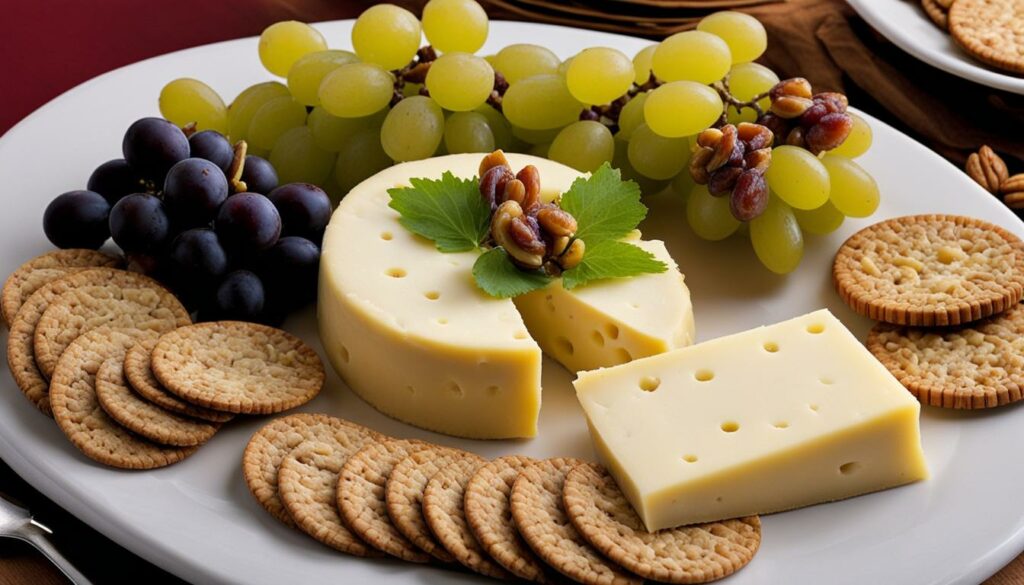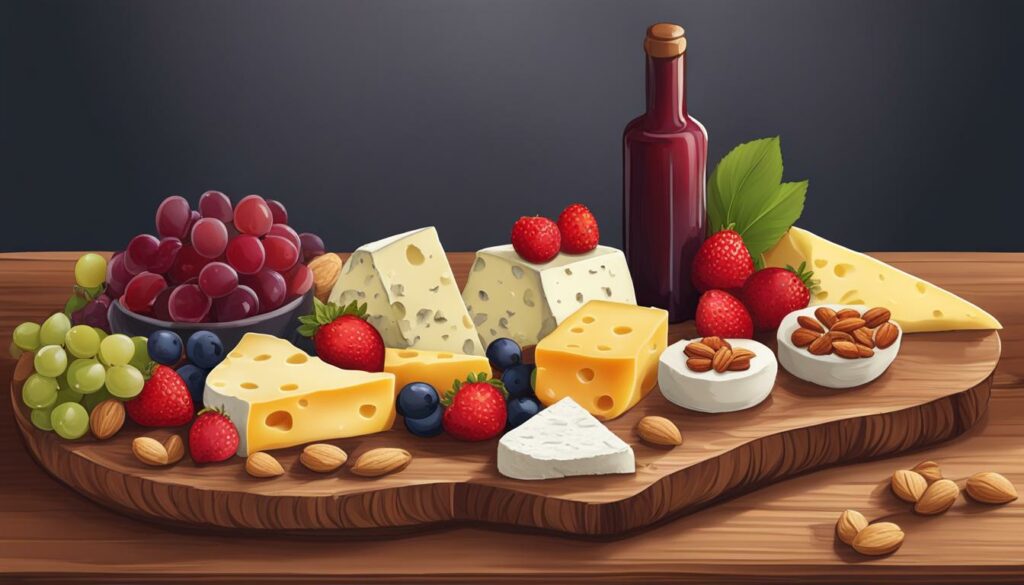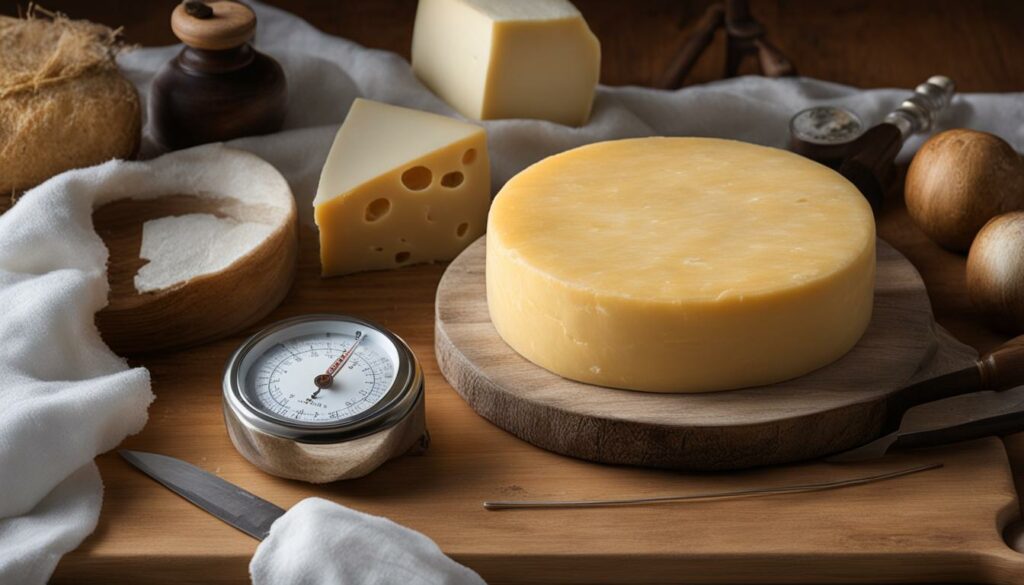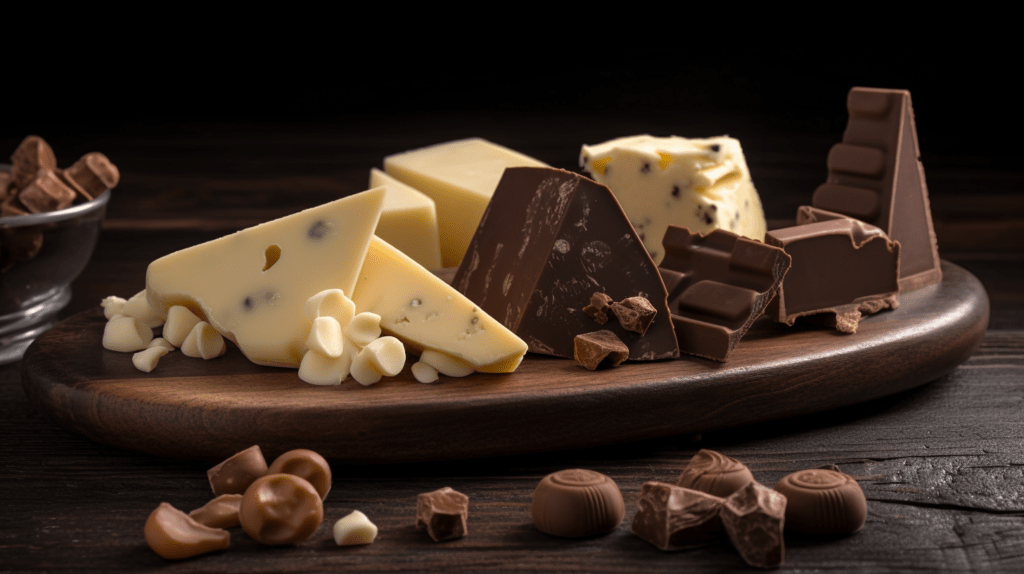Welcome to the world of Burgos cheese, a true gem in the realm of Spanish culinary delights. Bursting with flavor and crafted with care, this traditional, artisanal cow’s milk cheese from the region of Burgos is a must-try for cheese connoisseurs. Known for its creamy texture and delicate taste, Burgos cheese epitomizes the art of gourmet cheese-making. Whether you are a fan of soft cheese, a lover of European cheeses, or simply intrigued by the allure of artisanal creations, Burgos cheese is sure to captivate your taste buds and leave you yearning for more.
Join us on a journey as we explore the fascinating history, production process, taste profile, and culinary uses of Burgos cheese. Discover the secrets behind its rich and creamy texture, learn about the traditional methods that have been passed down through generations, and savor the exquisite flavors that have made this cheese a timeless favorite. Embrace the essence of Burgos cheese and uncover the true essence of Spanish cheese-making artistry.
The Rich Tradition of Castilian Cuisine in Burgos
Burgos is not only famous for its cheese but also for its rich culinary heritage. The region of Castilla y Leon, where Burgos is located, is known for its traditional dishes and gastronomic delights. Visitors to Burgos can indulge in a wide variety of local specialties, from the famous lechazo (milk-fed lamb) to the delicious sole with basil sauce.
The city offers a vibrant dining scene with affordable restaurants and a wide range of options to suit all tastes. Whether you’re craving hearty comfort food or haute cuisine, you’ll find it in Burgos. Take a culinary journey through the centuries and savor the flavors of Castilian cuisine.
Some of the traditional dishes you must try in Burgos include:
1. Lechazo Asado
Lechazo asado, or roasted milk-fed lamb, is a classic Castilian dish that showcases the region’s culinary expertise. The lamb is slow-roasted in a wood-fired oven until it becomes tender and succulent, with a crispy exterior. The meat is typically seasoned with garlic, rosemary, and salt, allowing the natural flavors to shine. A mouthwatering specialty that will leave you craving more.
2. Morcilla de Burgos
Morcilla de Burgos is a type of blood sausage that has a rich and savory flavor. Made with pig’s blood, rice, onions, and spices, it is a delicacy that is deeply rooted in Burgos’ culinary heritage. The unique combination of ingredients gives the morcilla a distinctive taste that is loved by both locals and visitors.
3. Queso de Burgos
No visit to Burgos would be complete without trying Queso de Burgos, the famous local cheese. Made from cow’s milk, this fresh cheese has a soft and creamy texture. It is often enjoyed on its own or served as a topping on bread or salads. The mild and delicate flavor pairs well with a variety of ingredients, making it a versatile addition to any dish.
Experience the culinary heritage of Burgos and indulge in the flavors of Castilian cuisine. Whether you’re a food lover or simply curious about the local gastronomy, Burgos will delight your taste buds and leave you with lasting memories.
Exploring the Ribera del Duero Wine Region from Burgos
Burgos serves as a fantastic starting point for discovering the enchanting Ribera del Duero wine region nearby. Renowned for its exquisite red wines, particularly those crafted from the tempranillo grape, this wine region offers a delightful sensory experience for wine enthusiasts. Immerse yourself in the beauty of the sprawling vineyards, embark on guided tours highlighting the winemaking process, and indulge in wine tastings that showcase the distinctive flavors of the region.
With its exceptional wines and picturesque landscapes, the Ribera del Duero wine region is a true treasure for wine aficionados.
During your visit, be sure to explore renowned wineries such as Villacreces, Arzuaga, and Vega Sicilia, where you can witness firsthand the mastery behind the creation of these fine wines. Take in the breathtaking beauty of the vineyards, learn about the winemaking process, and savor the distinct aromas and flavors during wine tastings that showcase the terroir of the region.
Notable Wineries in Ribera del Duero
| Winery | Location | Specialty |
|---|---|---|
| Villacreces | Quintanilla de Onésimo | Organic wines |
| Arzuaga | Quintanilla de Onésimo | Iconic red wines |
| Vega Sicilia | Valbuena de Duero | Prestigious wines |
Each winery in Ribera del Duero has its unique charm and showcases the exceptional craftsmanship of the winemakers. Whether you prefer bold and full-bodied reds or elegant and nuanced wines, there is a perfect bottle waiting to be discovered.
Embrace the opportunity to explore the Ribera del Duero wine region from Burgos, reveling in its natural beauty, rich winemaking heritage, and unforgettable wine tastings.
Pincho Hopping in Burgos: A Food Lover’s Paradise
Like many cities in Spain, Burgos is known for its vibrant tapas culture. In Burgos, tapas are known as pinchos, and going for pincho hopping is a popular activity for locals and visitors alike. The best time to enjoy pinchos is on Thursday or Friday night, or Saturday or Sunday afternoon.
Visitors can explore the streets of Burgos and hop from bar to bar, trying different pinchos paired with local wines. Some popular pinchos to try include:
- Charcoal-grilled sirloin with foie gras
- Quail’s egg with spicy chorizo
- Prawn croquettes
Pinchos are not only delicious but also a great way to experience the Burgos gastronomy and local specialties. Each bar has its own specialty pinchos, offering a unique flavor and culinary experience.
One of the highlights of pincho hopping in Burgos is the social atmosphere. The vibrant streets and lively bars create an energetic and friendly ambiance, where people gather to enjoy good food and company.
Whether you are a food lover or simply looking to immerse yourself in the local culture, pincho hopping in Burgos offers a delightful journey through the city’s gastronomic delights.
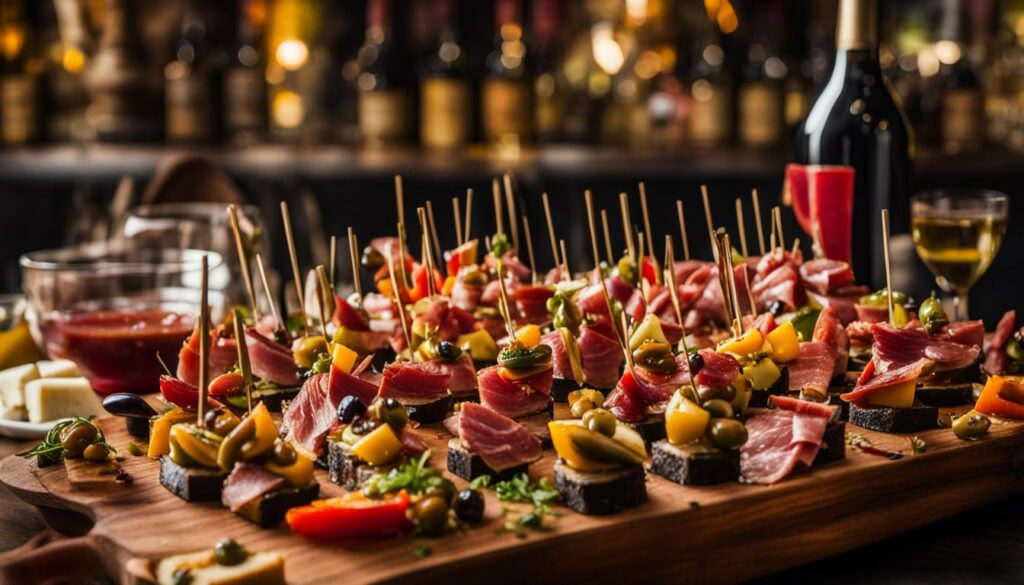
Pincho Hopping Recommendations:
| Bar Name | Specialty Pincho |
|---|---|
| Bar La Favorita | Grilled mushrooms with garlic sauce |
| Meson El 6 de Julio | Iberian ham croquettes |
| Taberna del Pez Lucio | Octopus skewer with paprika |
| Bar Codorniz | Piquillo pepper stuffed with cod and aioli |
The Gothic Splendor of Burgos Cathedral
One of the must-see attractions in Burgos is its stunning cathedral. Burgos Cathedral is a masterpiece of Gothic architecture, with its towering spires and intricate details. The cathedral was originally built in the 11th century as a Romanesque church but was later transformed into one of Spain’s first Gothic cathedrals in the 13th century. It is a UNESCO World Heritage Site and is known for its beautiful interior, including the labyrinthine naves, Gothic cloisters, and the resting place of the legendary figure El Cid.
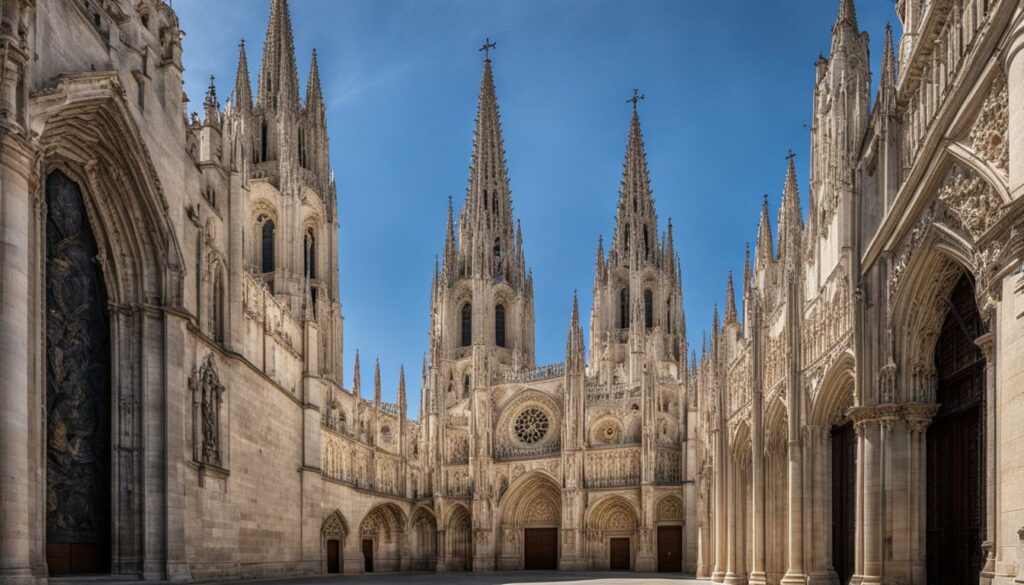
| Key Features | Details |
|---|---|
| Architectural Style | Gothic |
| Construction Period | 11th to 13th century |
| Height | 81 meters (266 feet) |
| Interior Highlights | Labyrinthine naves, Gothic cloisters, El Cid’s resting place |
| Status | UNESCO World Heritage Site |
Indulging in Michelin-Starred Dining in Burgos
If you’re seeking a truly exceptional dining experience, look no further than the Michelin-starred restaurant in Burgos. The city’s culinary scene reaches new heights with Cobo Vintage, a restaurant that epitomizes fine dining and culinary excellence. Under the direction of renowned Chef Miguel Cobo, Burgos cuisine is taken to the next level through the fusion of traditional flavors with influences from the northern region of Cantabria.
At Cobo Vintage, prepare to embark on a gastronomic journey that celebrates the best of Burgos. The menu showcases the region’s culinary heritage while offering a unique and innovative twist. Indulge in delectable dishes like morcilla biscuits, the perfect harmony of smoky scallops, or the delightful crunch of fresh cow’s milk croquettes.
Featuring sophisticated combinations of flavors and textures, each plate at Cobo Vintage is meticulously crafted to provide an unforgettable dining experience. The restaurant’s commitment to culinary excellence shines in every bite, elevating the already exceptional reputation of Burgos cuisine.
Enhance your dining experience by complementing your meal with a selection from the restaurant’s extensive wine list. Discover local wines that expertly pair with the flavors of your chosen dishes, enhancing the overall harmony of the meal.
Experience the Michelin-Starred Elegance of Cobo Vintage
“Cobo Vintage is a culinary gem, a temple of taste that combines tradition and innovation in perfect harmony. Every dish is a work of art, a symphony that delights the senses. Prepare to be dazzled and enchanted by the culinary creations that define Cobo Vintage.”
With its Michelin-star rating, Cobo Vintage stands as a testament to the culinary talent and dedication to excellence in Burgos. Immerse yourself in an unforgettable fine dining experience that exemplifies the gastronomic tradition of the region.

Indulge in the heights of culinary excellence at Cobo Vintage, Burgos’ premier Michelin-starred restaurant. Experience the innovative and delectable flavors that showcase the true essence of Burgos cuisine.
Exploring the Rich History of Burgos: Atapuerca and Monastic Retreats
Just outside of Burgos, you have the opportunity to delve into the fascinating history of the region. One of the most significant archaeological sites in Europe, Atapuerca, is a must-visit for history enthusiasts. This renowned site is home to Paleolithic caves that were inhabited by some of the earliest human beings in Europe over a million years ago. As you explore the caves, you will encounter captivating cave paintings and discover remarkable artifacts that provide invaluable insights into our ancient past.
Aside from the historical significance of Atapuerca, Burgos also harbors a rich religious heritage. The Monastery of Santa María la Real de las Huelgas is an awe-inspiring monastic retreat that showcases the region’s architectural beauty and religious devotion. Stepping into this sanctuary, you are transported back in time, immersing yourself in the tranquil ambiance and marveling at the intricate details of the monastery.
“A visit to Atapuerca and the Monastery of Santa María la Real de las Huelgas is a journey through time, offering glimpses into both our ancient past and the spiritual traditions of the region.”
Whether you’re an archaeology enthusiast or seeking moments of reflection and serenity, these historical sites in Burgos are sure to captivate your imagination and leave a lasting impression.
The Paleolithic Caves of Atapuerca
Atapuerca is an archaeological site of immense importance, renowned for its Paleolithic caves. These caves were once inhabited by our early ancestors, providing a window into their lives and the evolution of human civilization. The cave paintings, tools, and remains discovered in Atapuerca shed light on the behaviors, lifestyles, and cultural practices of our ancient predecessors.
The Monastic Retreats of Burgos
Burgos is home to several notable monastic retreats, including the Monastery of Santa María la Real de las Huelgas. These retreats offer a unique glimpse into the region’s religious history and traditions. From the stunning architecture to the serene atmosphere, these monasteries provide an opportunity for contemplation and appreciation of centuries-old spiritual practices.
| Highlights of Atapuerca | Monastic Retreats in Burgos |
|---|---|
| • Paleolithic caves with cave paintings | • The Monastery of Santa María la Real de las Huelgas |
| • Artifacts from the earliest human settlements in Europe | • Architectural beauty and historical significance |
| • Insights into the behaviors and lifestyles of ancient humans | • Tranquil atmosphere for reflection and spiritual connection |

As you explore Atapuerca and the monastic retreats of Burgos, you will be transported to different eras of human history, immersing yourself in the wonders of the past. These historical sites serve as reminders of the rich heritage and the enduring legacies that continue to shape the present-day Burgos.
The Art of Gin and Tonic in Burgos
While gin and tonic may have British origins, Spain has wholeheartedly embraced this classic drink and elevated it to new heights. In Burgos, you’ll find an array of gin and tonic creations that showcase the artistry of Spanish mixology. From trendy bars to picturesque rooftop terraces, there are plenty of options to indulge in the perfect G&T experience.
One notable establishment is Vara Cafe, renowned for its extensive selection of gins. Whether you prefer a London dry gin or a Spanish botanical-infused variety, Vara Cafe has something to suit every palate. Their knowledgeable staff can guide you through the menu, helping you discover new flavor profiles and combinations.
If you’re craving both delicious drinks and breathtaking views, head to the Silken Hotel’s rooftop terrace. Sip your gin and tonic while taking in the panoramic vistas of Burgos’ charming cityscape. It’s the perfect spot to unwind, socialize, and embrace the relaxed atmosphere of this vibrant Spanish city.

Whether you prefer a classic gin and tonic or enjoy experimenting with unique flavors and garnishes, Burgos offers a variety of options to fulfill your gin cravings. The local mixologists take pride in their craft, combining premium gins with carefully selected tonics and an assortment of botanicals and garnishes.
| Gin Selection | Atmosphere | Location |
|---|---|---|
| Vara Cafe | Trendy and vibrant | City center |
| Silken Hotel Rooftop Terrace | Sophisticated and panoramic | City center |
If you’re in the mood for a classic G&T, many bars offer traditional options with a twist, infusing unique flavors like rosemary, lavender, or citrus. For those seeking a more innovative experience, bartenders in Burgos have been known to experiment with exotic ingredients like passion fruit, hibiscus, or even local herbs and spices.
So whether you’re a gin enthusiast or just looking for a refreshing and sophisticated drink, be sure to explore the world of gin and tonic in Burgos. With its vibrant mixology scene and charming rooftop bars, you’re bound to discover a new favorite combination that perfectly captures the spirit of this beautiful Spanish city.
Understanding the Different Types of Spanish Cheeses
Spain is renowned for its diverse range of cheese varieties, each offering unique tastes, textures, and flavors. Let’s explore the different types of Spanish cheeses, including cow’s milk cheese, sheep’s milk cheese, and goat’s milk cheese.
Cow’s Milk Cheese
Cow’s milk cheeses, such as Burgos cheese and Mahon cheese, are known for their creamy texture and mild flavors. Burgos cheese, a traditional artisanal cheese from the region of Burgos, is famous for its delicate and soft consistency. Mahon cheese, on the other hand, hails from the island of Menorca and has a more robust flavor with hints of butter and citrus.
Sheep’s Milk Cheese
Sheep’s milk cheeses, like Manchego and Idiazabal, have a more complex taste profile with nutty and smoky notes. Manchego, perhaps the most well-known Spanish cheese, is made from the milk of Manchega sheep and offers a slightly tangy and herbaceous flavor. Idiazabal cheese, produced in the Basque Country, has a distinctive smoky taste due to the traditional smoking process it undergoes.
Goat’s Milk Cheese
Goat’s milk cheeses, such as Murcia al vino and Majorero, offer strong and slightly acidic flavors. Murcia al vino cheese, originating from the region of Murcia, is washed in red wine during its aging process, resulting in an intense yet balanced taste. Majorero cheese, made from the milk of Majorera goats in the Canary Islands, showcases a combination of sweet and sharp flavors, often with undertones of almonds.
Understanding the different types of Spanish cheeses allows cheese lovers to explore the wide array of options available. Whether you prefer the creamy and mild tones of cow’s milk cheese, the complexity of sheep’s milk cheese, or the bold flavors of goat’s milk cheese, Spanish cheeses offer something for every palate.
The Ins and Outs of Spanish Cheese Aging and Classification
Spanish cheeses are classified based on their aging process, which directly affects their taste, texture, and flavor. Understanding the aging and classification of Spanish cheeses can help you choose the perfect cheese for your palate. Here’s a breakdown of the different stages of cheese aging:
Fresh Cheese
Fresh cheeses, such as Burgos cheese, are soft and have a high water content. They are typically consumed soon after production and have a mild, delicate flavor. The short aging period allows these cheeses to retain their fresh, creamy texture.
Semi-Cured Cheese
Semi-cured cheeses are aged for 2-3 months, allowing them to develop a firmer texture. These cheeses have more pronounced flavors compared to fresh cheeses, but they still retain some of their creaminess. They strike a balance between mild and intense tastes.
Cured Cheese
Cured cheeses are aged for 4-7 months, resulting in a stronger flavor profile. The aging process intensifies the flavors and gives the cheese a firmer and drier texture. These cheeses are often enjoyed on their own or paired with fruits and nuts for a savory-sweet combination.
Old Cheese
Old cheeses are aged for over 7 months, allowing them to develop a very intense flavor. These cheeses have a crumbly texture and are often characterized by complex, nutty, and sharp flavors. They are best enjoyed in small portions, as their strong taste can be overwhelming.
Aside from aging, Spanish cheeses are also classified based on their fat content and firmness. The fat content can range from skimmed to extra fatty, offering a variety of options to suit different preferences. The firmness of the cheese can range from soft to hard, with different textures and melting properties.
Understanding the aging and classification of Spanish cheeses allows you to explore the diverse range of flavors and textures available. Whether you prefer a mild and creamy fresh cheese or a bold and crumbly old cheese, there is a Spanish cheese to satisfy every cheese lover’s palate.
Continue reading to discover the artistry and craftsmanship behind Spanish artisanal cheeses.
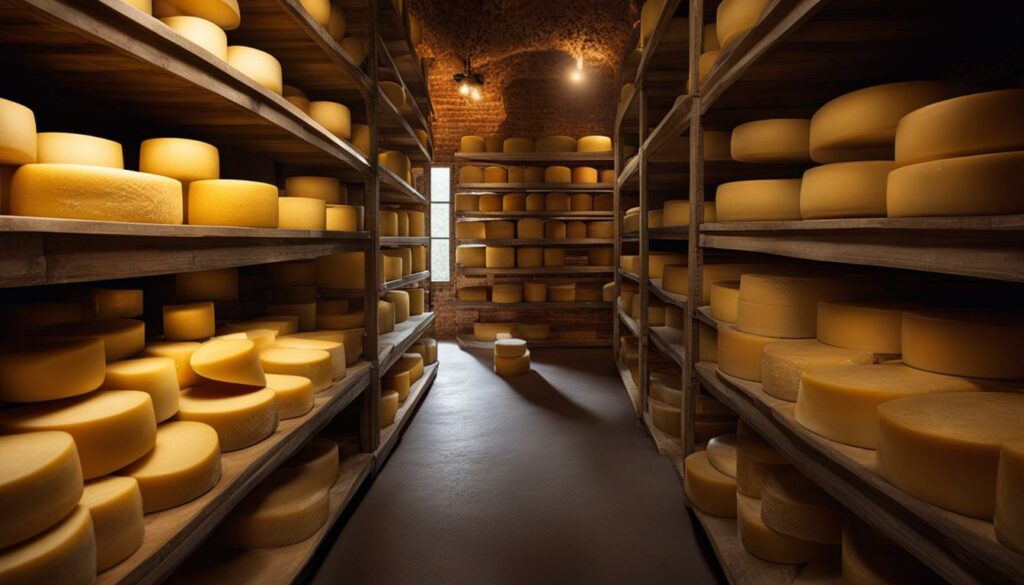
The Artistry of Spanish Artisanal Cheeses
Spanish artisanal cheeses are a true testament to the craft of cheesemaking. These cheeses are meticulously crafted using traditional production methods that have been passed down through generations. The artisan cheesemakers dedicate their time and expertise to create cheeses of exceptional quality, focusing on craftsmanship rather than quantity. The result is a range of artisanal cheeses that are unique in flavor and texture, reflecting the rich culinary heritage of Spain.
The artistry of Spanish artisanal cheeses begins with the selection and treatment of the milk used in the cheesemaking process. Only the finest quality milk is chosen, ensuring that the cheese will have a rich and flavorful taste. The milk is handled with care, following traditional techniques to preserve its natural qualities and enhance its flavors. This attention to detail and respect for the ingredients is what sets artisanal cheeses apart.
Another crucial aspect of the artistry of Spanish artisanal cheeses is the aging process. The cheeses are carefully aged in optimal conditions, allowing them to develop their unique flavors and textures. The aging process can range from a few weeks to several years, depending on the type of cheese. Over time, the cheeses acquire complex flavors, developing nuances that make them truly special.
“Artisanal cheese production is a labor of love and a true art form. The cheesemakers pour their passion and expertise into every wheel of cheese they create, resulting in extraordinary flavors and textures that cannot be replicated.”
The Craftsmanship of Spanish Artisanal Cheeses
The craftsmanship involved in the production of Spanish artisanal cheeses is a reflection of the dedication and skill of the cheesemakers. Their expertise allows them to carefully control every step of the cheesemaking process, ensuring the highest quality in every batch. From curdling the milk to shaping and pressing the cheese, every stage requires precision and attention to detail.
The cheesemakers’ experience and knowledge enable them to make crucial decisions along the way, such as determining the optimal time for flipping the cheese or adjusting the temperature and humidity for optimal aging. These small but significant details contribute to the development of flavors and textures that are unique to each artisanal cheese.
The craftsmanship of Spanish artisanal cheeses is highly regarded by cheese enthusiasts around the world. These cheeses are considered gastronomic jewels, appreciated for their exceptional taste and impeccable quality. Whether enjoyed on their own or paired with other culinary delights, Spanish artisanal cheeses elevate any dining experience.
Comparison of Spanish Artisanal Cheeses
| Cheese | Texture | Flavor | Aging Time |
|---|---|---|---|
| Manchego | Firm and crumbly | Rich and nutty | Minimum 60 days |
| Idiazabal | Firm and oily | Smoky and tangy | Minimum 60 days |
| Cabrales | Semi-soft and creamy | Strong and pungent | Minimum 2 months |
These are just a few examples of the incredible variety of Spanish artisanal cheeses available. Each cheese has its own unique characteristics, making the world of Spanish artisanal cheeses a wonderful exploration for cheese lovers.
Experience the artistry and craftsmanship of Spanish artisanal cheeses for yourself. Discover the extraordinary flavors and textures that can only be found in these exceptional cheeses.
Conclusion
In conclusion, Burgos cheese is a treasured Spanish delicacy that exemplifies the rich culinary traditions and diverse gastronomy of the region. Its creamy texture, delicate flavor, and versatility make it a favorite among cheese enthusiasts. Whether enjoyed on its own, as part of a cheese board, or incorporated into various dishes, Burgos cheese never fails to impress with its quality and taste.
However, Burgos is not just about cheese. The region offers much more to explore, including its rich history, vibrant dining scene, and cultural attractions. From the Gothic splendor of Burgos Cathedral to the fascinating archaeological site of Atapuerca, there is something for everyone. Indulging in the local cuisine, venturing into the world of gin and tonic, and exploring the nearby Ribera del Duero wine region are experiences that further enhance the visit.
Whether you’re a cheese lover or a food enthusiast, a trip to Burgos promises to be an unforgettable culinary journey through Spain’s fresh delights. Discover the artistry behind Spanish artisanal cheeses, immerse yourself in the rich tradition of Castilian cuisine, and soak up the beauty of this enchanting region. From the first bite of Burgos cheese to the last sip of Ribera del Duero wine, every moment will leave you craving more.
FAQ
What is Burgos cheese?
Burgos cheese is a traditional, artisanal cow’s milk cheese from the region of Burgos in Spain. It is known for its creamy texture and delicate flavor.
What makes Burgos cheese different from other cheeses?
Burgos cheese stands out for its soft and creamy texture, which is achieved through a careful production process and the use of high-quality cow’s milk.
How is Burgos cheese made?
Burgos cheese is made by curdling cow’s milk and allowing it to ferment and coagulate. The curds are then drained and pressed to achieve the desired texture.
What does Burgos cheese taste like?
Burgos cheese has a delicate and slightly tangy flavor, with subtle notes of sweetness and a creamy mouthfeel.
How can I use Burgos cheese in cooking?
Burgos cheese is versatile and can be enjoyed in various ways. It can be spread on crackers or bread, used as a filling in pastries, melted in dishes, or even crumbled over salads.
Can I find Burgos cheese outside of Spain?
Yes, Burgos cheese is exported to many countries and can be found in specialty stores and gourmet food markets around the world.
What other Spanish cheeses should I try?
Spain offers a wide variety of delicious cheeses. Some popular ones include Manchego, Idiazabal, Mahon, and Cabrales.
How should Burgos cheese be stored?
Burgos cheese should be kept refrigerated, wrapped in wax paper or plastic wrap to prevent it from drying out.
Can I pair Burgos cheese with wine?
Yes, Burgos cheese pairs well with both red and white wines. For a classic combination, try it with a light white wine or a fruity red wine.
Is Burgos cheese suitable for vegetarians?
Yes, Burgos cheese is made using vegetarian-friendly rennet, so it is suitable for vegetarians.
How long does Burgos cheese last?
Burgos cheese has a relatively short shelf life and is best enjoyed within a few weeks of purchase. It is recommended to consume it within a month for optimum freshness and flavor.

